The Basenji University
CLICK to return to The Standard Dissected
204 The Standard

Prepared by Susan Coe, Laurie Stargell and Pamela Geoffroy
Hindquarters

The Basenji Standard states:
Medium width, strong and muscular, hocks well let down and turned neither in nor out, with long second thighs and moderately bent stifles. Feet—Same as in "Forequarters."
Keeping in mind that the desire for moderation in Basenjis (as discussed in "Forequarters") is to produce a multi-purpose breed, let's now look at hindquarter construction.
Starting at the top the angle of the hip is very important to how the rear leg functions and that is introduced in the section called "Neck, Topline, Body" where a high set tail is called for. For a dog to have a high set tail it must also have a fairly flat pelvis.
When researching this subject it seems that most authors avoid giving actual, decisive numbers for the various angles in the rear leg. The pelvis itself doesn't have a convenient ridge along it, as the shoulder blade does, to use as a reference. Also the way the dog is standing at the moment, which is never quite the same, changes the angles too much to be decisive.
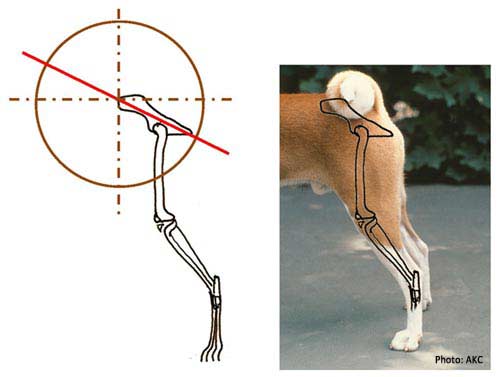
With the comments above in mind, consider the diagram above showing the sketetal representation of the structure of the hindquarters with the circle and red line indicating the angle laid out the same as those in the section "Forequarters." The inserted photo shows the same skeletal rear representation superimposed on a dog to help visualization.
The pelvis, unlike the shoulders in the forequarters, is attached to the spine and does not rotate. Its major job is to transfer the force generated by the rear action to the spine.
The correct pelvis appears to make a shelf behind the tail, which is clearly shown in the photo. The pelvis needs to be long as it is a major point of attachment for the muscle group making up the rear leg.
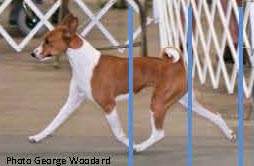 When a dog trots, it is the angle of the pelvis that determines how much the leg reaches under the body as compared to how much it extends out behind. The dog should reach under the body about the same as his other leg drives out behind the body. This should give the dog easy, efficient movement so that he does not tire as he hunts. The photo to the right demonstrates this.
When a dog trots, it is the angle of the pelvis that determines how much the leg reaches under the body as compared to how much it extends out behind. The dog should reach under the body about the same as his other leg drives out behind the body. This should give the dog easy, efficient movement so that he does not tire as he hunts. The photo to the right demonstrates this.
If the pelvis is too flat, the action of the rear legs will be mostly behind the dog, which gives a very showy gait but not an efficient gait and thus is not desirable. If the pelvis is too steep, all the rear action is under the body. The rear leg is going to interfere quite a bit with the front leg, which requires the dog to compensate making the gait inefficient. This would mean the dog is working harder to travel the same distance, so again, this is incorrect.
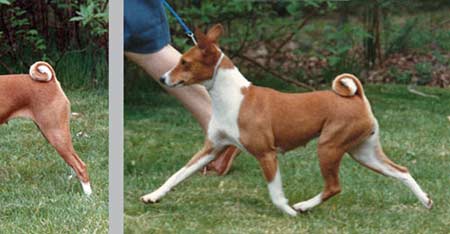
Here is an example of a dog with a steep pelvis standing and on the move. She has compensated by moving with her rear higher than her withers and her rear foot is overtaking her front leg under her body. Expect to see more information on movement virtues and faults in the section on "Gait."'
Now commenting directly on the words in the Standard.
"Medium width" is referring to the view from the rear as shown to the below left.
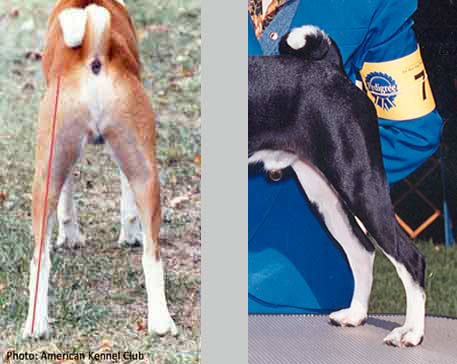
The qualities of "strong and muscular" can be admired in the same photo of the red dog. The black dog above right demonstrates the strength and musculature of the rear from the side view.
"Hocks well let down" is an old time term that means the hock joint should be close to the ground or the hocks should be short not long. See photo of the black dog above to see well let down hocks. The desire for short hocks is based on the function of the breed as an enduring hunting dog. Long hocks appear in animals that need a short burst of speed, like say jackrabbits that only need to dart to their hole to survive another day. A coyote does not catch every rabbit but he is able to keep moving to take advantage when an opportunity arises. Animals that need to travel long distances fairly quickly and then have a reasonable burst of speed do best with short or well let down hocks.

Learn to look carefully at hocks and not be fooled by color markings when comparing dogs. Markings can be very deceiving. This is the same dog with correct well let down hocks photographed from opposite sides, but because of the markings the hocks do not seem the same.
"And turned neither in nor out" is demonstrated in the photo of the red dog from the rear above with a red line added to show the column of support from the hip through the foot that makes the strongest rear. The straight column of support insures all the power from the rear in both the trot and the gallop is carried efficiently through the rear to make forward propulsion easy at both gaits
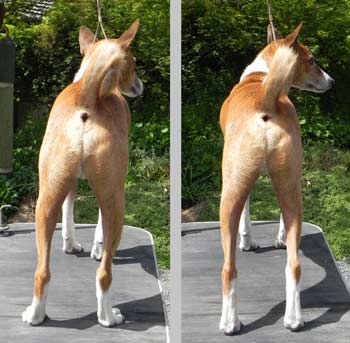
Most handlers learn how to stack their dogs to make the rear appear "turned neither in nor out". This is one of the reasons judges like to look at the dog, often walking around it when it is standing on its own. Seeing the dogs standing on their own is a better way to judge this feature. Photos above show a dog with cowhocks corrected to stand straight.
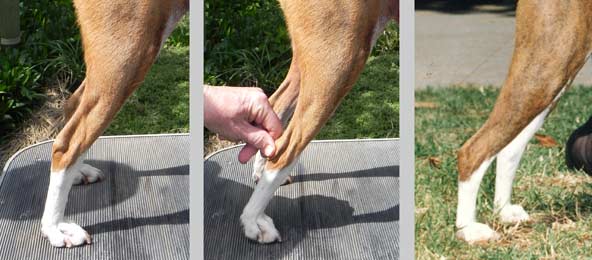
A fault that is sometimes a problem for Basenjis is the strength of the joint between the hock and the lower thigh. With the dog standing comfortably if one applies a small amount of pressure to this joint, the joint collapses forward and the dog steps forward to be more comfortable. This is a real weakness in the construction of the rear leg which reduces the functionality of the hock. Compare the faulty hock to the strong, correct hock shown in the photo to the far right in the series.
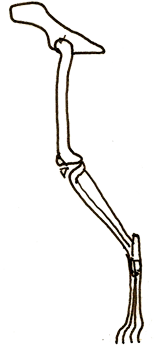 The "with long second thighs" can be seen in the skeleton to the right. It means the upper thigh and lower or second thighs are actually equal length but are both reasonably long to allow for good locomotion at both the trot and the gallop. Because
The "with long second thighs" can be seen in the skeleton to the right. It means the upper thigh and lower or second thighs are actually equal length but are both reasonably long to allow for good locomotion at both the trot and the gallop. Because 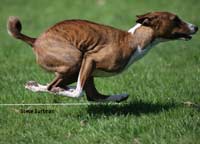 the Basenji is a squarely-built short-coupled breed, great long rear legs would simply get entangled with the front under the body at a trot. But, because Basenjis are also a galloping breed, the bones need to be long enough to reach well forward at the gallop. See the photo to the left for the galloping position showing how the rear legs reach forward under the body. The rear legs' long bones are folded up in this position like a big coiled spring. The force in this coil is expended in forward movement as the dog vaults over the front leg.
the Basenji is a squarely-built short-coupled breed, great long rear legs would simply get entangled with the front under the body at a trot. But, because Basenjis are also a galloping breed, the bones need to be long enough to reach well forward at the gallop. See the photo to the left for the galloping position showing how the rear legs reach forward under the body. The rear legs' long bones are folded up in this position like a big coiled spring. The force in this coil is expended in forward movement as the dog vaults over the front leg.
It is the "and moderately bent stifle" that causes a great deal of disagreement among breeders. When the simple word "moderate" appears, each person tends to have a different opinion of what it means. One person's "moderate" is someone else's "way to straight." While another's person's perfect is another's terribly over-angulated.
Keep in mind that the model skeleton shown above right is offered as typical and moderate as requested in the standard. Looking at a couple of specialized breeds may clarify the differences. A specialized sighthound breed like the whippet has very long rear leg bones so when the hock is at its vertical position it is much further behind the dog. The extremely long bones, which are especially useful for galloping specialists, place the hocks in this position. At the other extreme the straight hind leg and stilted gait is said to be the hallmark of the Chow which is the most extreme breed at the other end of the spectrum. When in the vertical position, the Chow's hock is directly under the socket where the upper thigh joins the hip.
If one considers the complexity of the rear leg joints, one can understand how dogs of extremes – very straight or overly bent – apply extra stresses when the dog must withstand hunting for long hours. One realizes that extremes simply are not desirable on an all-purpose hound.
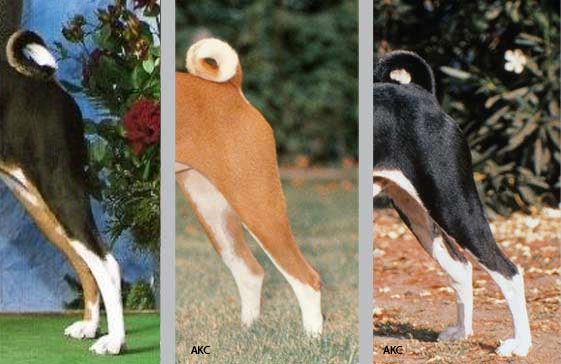
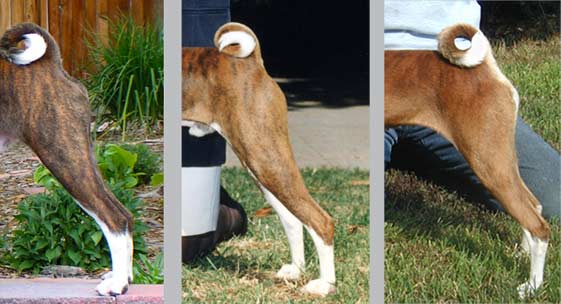
Take a look at these photos, which show a range of dogs that could be said to have "moderately bent stifle." If you look at several photos of the same dog, you will find that the rear does not always look the same. Do not fall in love with a photo. A clever handler can increase the apparent bend of stifle by how the dog's rear legs are set and then again, some dogs tend to straighten their rears creating the opposite affect, a dog that is actually better angulated than it appears in the photo.

Here are two rears that are too straight lacking bend of stifle, even moderate bend of stifle. Each appears to have weak hock joints as well.
One can only speak of the parts of a dog so long before the fact that all the parts have to interact becomes apparent. Beyond the bend of the stifle itself is the balance between the front and the rear leg assemblies. Because of the way the rear functions compared to the front at a gallop, the rear has more actual power than the front at the trot. However, one still does not want an extreme imbalance.

In these three photos the dog on the left is too straight in front and too bent, too angulated in the rear so is badly unbalanced with his straight front. The center dog is too straight in front but the rear is equally straight. The center dog would not have particularly easy movement but the rear would not overpower the front as much so the dog would hold up better on the field. The example on the right is a dog with proper angulation both in front and rear. This dog should have easy movement, which should carry him far at either the trot or the gallop. This is by far the most desirable example of the three dogs presented here.
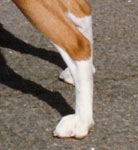
Feet—Same as in "Forequarters."
Click to revisit the section on feet in "Forequarters".
Comment on Section
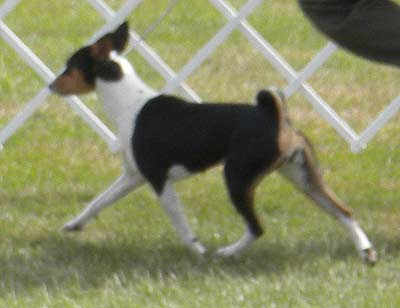
The tricolor above demonstrates a good moving hindquarters that is balanced with the forequarters. The balance between the moderate forequarters and hindquarters strongly affects how each dog moves from every angle. Problems with conflict between the two ends of the dog will make a Basenji trot without the easy gait, "...the swift, effortless gait" that is desirable for the breed.
Copyright the Basenji Club of America 2013 CLICK to return to College for Basenji Breeders
Contact the Basenji University with comments, questions, updates and Workbooks at BasenjiU@basenji.org
.
We are indebted to the Basset Hound Club of America for the use of their Basset Hound University templates.